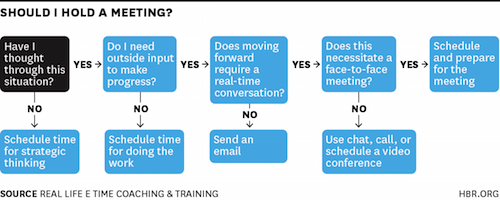
Not a fan of meetings? We know how you feel.
Frustrated.
Unproductive.
Bored.
We’ve all been there.
Since introducing Jell, things have gotten better around here. Online standups now help get everyone in sync on day-to-day activities. So when we do schedule meetings, it’s to discuss the important issues that will help grow the business and bring us all together as a happy, productive team.
In this post, we’re going to share several signs and signals your meetings may be inefficient, then share tips for making them more purposeful.
To make improvements, we first need to look at the hazards of unfruitful meetings.
The Dangers of Mindless Meetings
Bad meetings aren’t just bad for morale. They can also cause some serious damage to your profitability.
For example, a recent audit at a large U.S. company revealed that its weekly executive meeting was unknowingly draining the business of an astonishing 300,000 hours a year.
In another instance, a contractor we know once spent eight hours traveling to and from a three-hour client meeting—only to discover the issues being discussed could have been easily addressed in a 15-minute phone call or simple integrated Slack channel.
According to Atlassian, U.S. businesses devote $37 billion dollars worth of salaries to mindless meetings.
In each case, the people orchestrating these meetings had no idea they were doing damage. Recognizing red flags is the first step to ensuring the same thing doesn’t happen to you.
You Know A Meeting Sucks When…
1. There’s no clear agenda. Every meeting needs a mission. If participants don’t have a clear understanding of why they’re in the room, they’re going to have a hard time achieving anything important.
2. The agenda has nothing to do with company objectives. Anything you can’t tie back to OKRs should be saved for other office communication mechanisms such as Zoom and HipChat.
3. There’s no designated end time. Why not?
4. One or two people do all the talking. If the others don’t have something to add, they probably don’t need to be there.
5. There’s not enough room for everyone to sit. This is a surefire sign you’ve invited too many people. The fewer people there are in the room, the less likely your meeting is to veer off topic into tangents.
6. There’s no goal. If there’s no desired outcome, there’s no need for a meeting.
7. Conversations revolve around what everyone’s working on. This is what daily online standups are for. Not meetings.
8. Someone falls asleep. It happens to 39% of people when they’re at extraneous meetings they don’t need to attend.
9. You spend hours preparing for one meeting. Unless the objectives of the meeting are going to have a major impact on your brand’s bottom line, this is usually a monumental waste of time.
10. There are more people in the room than there are topics to discuss. Parkinson’s law of triviality states that people in groups tend to give disproportionate weight to pointless discussions. When no one wants to admit they don’t understand why they’re in the room, they’ll turn to trivial topics.
You regularly use the phrase “let’s schedule a meeting.” As in, “That’s an interesting idea, Tom. Why don’t we schedule a meeting to discuss it in more detail next Tuesday?” Very few issues warrant the need to postpone creativity and productivity because a team leader’s not ready to discuss it yet.
How to Make Meetings More Productive
We’re not saying all meetings are bad. Used in moderation, they can be a cornerstone of collaboration.
Before you schedule another meeting, ask yourself two questions:
1. Does this warrant a meeting?
Do you really need to hold a meeting? Or is your reaction to every half-baked idea to get everyone into a room to hash out details and decide what to do next? Harvard Business Review author Elizabeth Grace Saunders has a great decision tree you can use to determine the necessity of a meeting:
2. Can this be accomplished with a written update instead?
Because they’re designed to get your team in sync within a few minutes a day, online standups are often a better alternative for coordinating day-to-day activities. They can help you avoid getting “stuck in the weeds,” so meeting time is saved for the big, important issues.
When you do hold meetings, use these best practices to keep them on-point and productive:
Plan ahead. What really needs to be discussed? Prepare a brief agenda or talking points to share with everyone beforehand. By enabling team members to think ahead, you’ll make the most efficient use of your time together.
Limit participants. Include only the people who need to be there to make important decisions and ensure they get implemented.
Keep it short. If you don’t need an hour, don’t block off an hour on the calendar.
With these simple steps, you can easily create a cadence of targeted successful meetings that result in getting more work done and reaching more profitable achievements.

